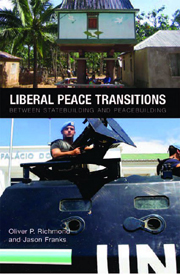Book contents
- Frontmatter
- Contents
- Acknowledgements
- List of Acronyms
- Introduction: a Framework to Assess Liberal Peace Transitions
- 1 Cambodia: Liberal Hubris and Virtual Peace
- 2 Bosnia: Between Partition and Pluralism
- 3 Liberal Peace in East Timor: the Emperors' New Clothes?
- 4 Co-opting the Liberal Peace: Untying the Gordian Knot in Kosovo
- 5 Building/Rejecting the Liberal Peace: State Consolidation and Liberal Failure in the Middle East
- Conclusion: Evaluating the Achievements of the Liberal Peace and Revitalising a Virtual Peace
- Select Bibliography
- Index
3 - Liberal Peace in East Timor: the Emperors' New Clothes?
Published online by Cambridge University Press: 12 September 2012
- Frontmatter
- Contents
- Acknowledgements
- List of Acronyms
- Introduction: a Framework to Assess Liberal Peace Transitions
- 1 Cambodia: Liberal Hubris and Virtual Peace
- 2 Bosnia: Between Partition and Pluralism
- 3 Liberal Peace in East Timor: the Emperors' New Clothes?
- 4 Co-opting the Liberal Peace: Untying the Gordian Knot in Kosovo
- 5 Building/Rejecting the Liberal Peace: State Consolidation and Liberal Failure in the Middle East
- Conclusion: Evaluating the Achievements of the Liberal Peace and Revitalising a Virtual Peace
- Select Bibliography
- Index
Summary
Introduction
At midnight on 19 May 2002, in the presence of Kofi Annan, the United Nations General Secretary, East Timor became a democratic republic. This auspicious event saw the creation of one of the world's newest states and represented an important marker in the liberal statebuilding process that hoped to end a period of ‘western duplicity and self-interest with a brutal Third World dictatorship that had consigned East Timor to almost twenty-five years of systematic killing, gratuitous violence and primitive plunder’. Indeed the events driving foreign occupation of East Timorese history have been far from constructive for the nascent state and its population. The period following colonial occupation has consisted primarily of a succession of occupations and civil war that have impoverished and traumatised the tiny population of this tropical island.
A Portuguese colony from the eighteenth century, East Timor suffered Japanese occupation in the Second World War and then, from 1975, Indonesian domination and a civil war that culminated in eventual intervention of the UN in 1999 and InterFET (International Force East Timor) during and after the violent withdrawal of pro-Indonesian militias. The UN missions in East Timor; UNAMET (1999), UNTAET (1999–2002), UNMISET (2002–5) and UNOTIL (2005–6) were peacekeeping and statebuilding projects, variously described as ‘governance or national-building missions’, intended to end the civil war and years of foreign oppression through the creation of liberal peace and the construction of an independent liberal democratic state in East Timor.
- Type
- Chapter
- Information
- Liberal Peace TransitionsBetween Statebuilding and Peacebuilding, pp. 83 - 113Publisher: Edinburgh University PressPrint publication year: 2009

